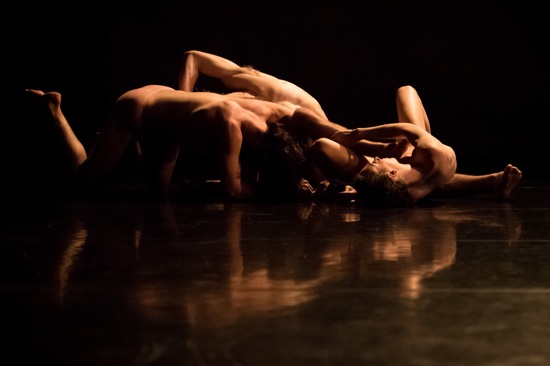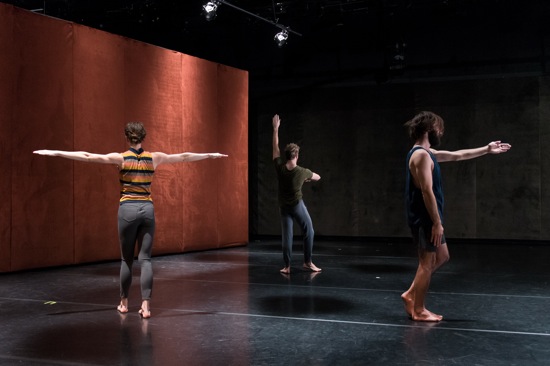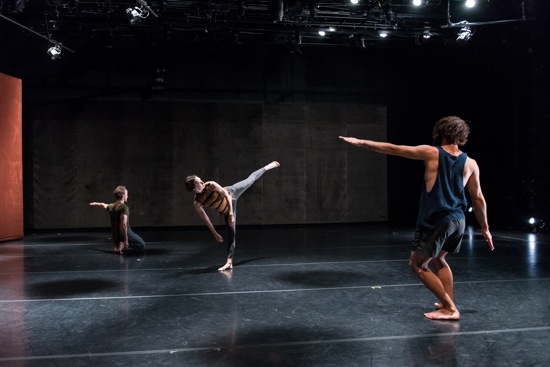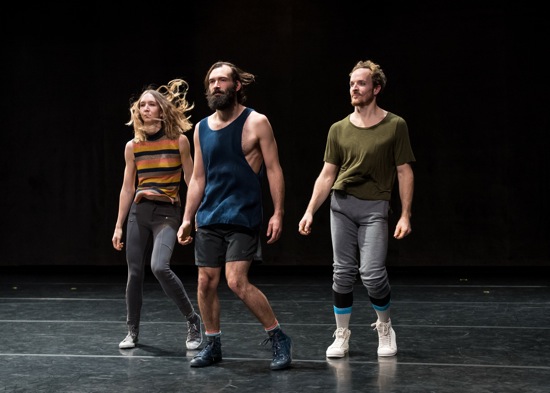Pavel Zuštiak & Palissimo Company at New York Live Arts.

Nicholas Bruder, Emma Judkins, and Justin Morrison in Pavel Zuštiak’s Custodians of Beauty. Photo: Ian Douglas
It’s very dark down here. This is not how we’re used to entering New York Live Arts’ black-box theater: down the stairs, walking along a narrow corridor at the edge of the performing area. There are a couple of people with flashlights, but they don’t fully light the way. Is this a birth canal of sorts? And into what?
The overture to Pavel Zuštiak’s Custodians of Beauty is as disconcerting as our entrance. Once we’re seated, and everything goes black, we hear the roar and rumble of Christian Frederickson’s score start up; every few seconds, a scraping noise is heard—“ssshhpt!” Then rapidly undulating black lines appear—racing across a scrim at the very front of the stage from our left to our right. They’re thick to begin with, then bleed into one another, grow, thin down; the background turns orange. Then the lines vanish, and we see—dimly—two, no, three figures in black crouched together, squirming into a different configuration. Suddenly three overhead spotlights go out and the scrim falls.
Over the course of ninety minutes, we will see a number of events—some very brief—separated by blackouts. Zuštiak is depriving us of transitions; each new scene occurs in isolation—without apparent cause or effect. Frederickson’s score hints at happenings that don’t materialize here. Later Plato’s cave allegory pops into my head; people chained and immobilized from birth assume the shadows that pass on a surface in front of them to be reality. Perhaps connecting this to Custodians of Beauty is only muddying the waters, but, watching the remarkable work, I get the feeling that Zuštiak is showing us only part of a reality that is known to him, the dancers, and his other collaborators in Pavel Zuštiak & Palissimo Company (including assistant choreographer Lindsey Dietz Marchant).
Interviewed by Jeremy Barker for “Context Notes” that appear in the program, Zuštiak said that he is currently interested in transferring to dance-making the process employed by sculptors: stone is gradually chiseled away from a mass of material to “reveal” the form within. That means, I think that he starts by creating images with his collaborators and then, in his words, “I want to see how much I can take away”—without, of course, compromising the essential nature of the ideas.
The effect is intriguing, disturbing, and made all the more enigmatic by the work’s title. In 2009, Pope Benedict XVI applied the words “custodians of beauty” to artists while addressing a group of them in the Sistine Chapel (additional “Context Notes” by Melanie George point this out). Did he mean that they extract from the beauty around them something that is essential to it and, by doing so make it—or the vision of it— endure?
The black-clad figures become increasingly visible. You can’t be sure of the identity of the person in the face-concealing cap turning her/his bent legs in and out, doing a headstand against a gold velvet wall at the back (I think it’s Justin Morrison). The next post-blackout image shows a second person (Emma Judkins) jostling Morrison. Blackout. Now there are three (Nicholas Bruder has joined). Successive blackouts will give us brief glimpses of them paired variously or all three. Their shadows accompany them as they create poses as symmetrical as Rorschach blots. It’s as if the images we do see have been snipped from a film, while the shots providing continuity have been eliminated.

(L to R): The spaces between. Emma Judkins, Justin Morrison, and Nicholas Bruder in Pavel Zuštiak’s Custodians of Beauty. Photo: Ian Douglas
Zuštiak creates impressions of absence in various ways. Bruder walks on, barechested now, and delivers a “speech” to us in gestures and without facial expressions. His arms rounded to frame his head may mean “so big,” or not; his fist may be threatening. Or not. Is he pointing at something? Shortly after this, the stage becomes an arena for absence. What may be a distant train or surf roars, while we contemplate the space devoid of humans for quite a long time. Until a blackout intercedes between emptiness and three figures huddled on the floor—this time nearly nude and tangling together. Later, we hear what might be a wittily devised conversation between two spectators at this very event (text by Alexandra Collier). They compare impressions, agree, and argue good-naturedly about what they’ve seen. But since they’re invisible and distanced by technology, they are half absent.
Simon Harding’s set (he also designed the videos) consists of two very large velvet walls—one goldish one and the other red-orange. When invisible hands wheel them into new positions, they alter the space and conceal what once was visible. At one point, the performers and two stagehands pick up the plastic scrim that’s now lying at the feet of the front row, and move up the side aisles with it, covering and then uncovering the audience. If you turn your head and look behind you, you see spectators’ hands reaching up to speed the process along.

(L to R): Justin Morrison, Emma Judkins, and Nicholas Bruder in Custodians of Beauty. Photo: Ian Douglas
Zuštiak is interested in bridging the separation between the audience and the performers Here’s another way he manages this. Morrison asks where “Rose” is, and I guess someone raises a hand, because he walks up one aisle and returns to the stage with a woman; asking her to hold down the place for a few minutes; the performers exit. “Rose” is on the spot; she could be any of us, and our hearts are with her. She happens to be young and very beautiful with long blond hair and wearing a stylish, flowing black outfit. She smiles, looks toward one wing, looks a little harder in the other direction, shrugs, adjusts her clothing, and then, rising to the occasion, does about three steps of what could turn into a soft-shoe number. Bruder returns and presumably tells her she can return to her seat. I imagine he thanks her.
I consider her an intermission, because after the dancers have returned in different clothes (costume design by Asta Bennie Hostetter), the walls get moved more often, Joe Levasseur’s splendid lighting creates more dramatic contrasts, and the music lays out more assertively rhythmic sounds.
Morrison (what a mover!) walks on wobbly half-toe, gradually increasing the scope of his tiny steps and drooping his body forward. Bruder sings words that I can’t always make out (“earthquake is one of them”). Judkins’s solo is notable for the wonderfully precise way she almost jumps into a perch on one half-toe, the other leg stretched behind her. She does this suddenly several times without ever quavering. The men wrap their arms around her and carry her into a blackout.
For the last event, they all wear sneakers, and no wonder. The step that the three, starting in a line, execute for many minutes is like a refined version of a preparation for something big. Feet apart, they jog, barely off the ground, from one foot to the other. It reminds me a little of the way basketball players dance when they’re guarding a member of the opposing team or trying to fake one out. Judkins has taken her hair down, and it swings with the her movements.

(L to R): Emma Judkins, Nicholas Bruder, and Justin Morrison in Pavel Zuštiak’s Custodians of Beauty. Photo: Ian Douglas
The three dancers keep their bodies erect, their arms still, their feet agile. Drums, metallic clangs, and distorted voices submerge and combine to given them rhythmic support. They seem at ease, relaxing a bit into the steps of what turns into a precisely configured routine. Now they all go in the same direction; now one swings in the opposite way. They can cover space without changing the nature of the step, so that they appear in new spatial designs. They can travel backward or forward.
They gradually increase the scale of this precision routine—adding a gesture, a turn, a higher spring. They bounce front and back rather than from side to side. Abetted by the music, they get wilder, looser as the lights begin to darken. This is still dancing stripped of all excess, but not of vibrancy and the demand for endurance.
The last mysterious image is of absence becoming a presence. In a pool of dim light, Bruder spins slowly, holding a long pole horizontal to the ground. As he does this, he also rotates the pole. At first, it appears to thicken. Then you realize that he is gradually unfurling a gray silk flag, a storm cloud of a flag. You have no idea of how big it is going to get. And something else: while this is happening, the air begins to smell sweet.
Custodians of Beauty tells no stories. It is a dance of images. You watch them recur, but they’re not the same as they were before. They hint at meanings that vanish when the lights go out. You sense something that is not there hovering beneath what is there. Yet what is before you holds—compels— your attention. If this rich, yet pared-down dance were a meal, you’d receive a few sips of fine wine, a slice of warm bread, and a handful of freshly picked berries, and you’d go home feeling full.

Zustiak’s piece was shown in the Washington, DC area last month at American Dance Institute. I felt that he was either joking or being purposely annoying or playing teacher, and said so in a review for http://www.danceviewtimes.com (Nov. 20). My editor tells me that the review has resulted in my being uninvited to review again at ADI. Be that as it may, I feel it was my duty as a reviewer to point out that the choreographer seemed to know what he was doing. The dim lighting, noise, awkward timing, dud impacts, etc. were intentional.
I suspect that the American Dance Institute’s decision to ask George Jackson not to review its presentations in the future has less to do with his negative opinion of Pavel Zuštiak’s work (after all, he’s a critic) than with the suggestion in his Dance View Times review that the choreographer might be joking. In an essay about Merce Cunningham by Carolyn Brown, she recalled an incident after a London performance by the Cunningham company in the 1960s. A small group of students had been brought backstage, and one asked,”Is he serious? I mean, isn’t he just pulling our leg?” To which Brown replied, “Do you really believe that a man would spend his whole life working this hard, even going into debt, merely to pull your leg?”
The next best thing to being there is reading what Deborah wrote about it.
Indeed!